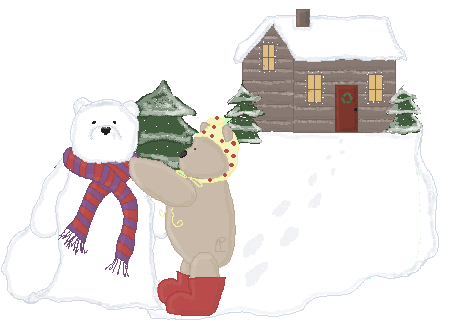


|
Snowflakes A tiny particle, such as a speck of dust, smoke, or salt, is at the center of every snowflake! Snowflakes form when water vapor freezes in crystal form around a speck of dust or other debris in the air. These particles, called "cloud condensation nuclei" (CCN) may be only a millionth of a meter wide and weigh a trillionth of a gram! If there aren't any CCNs around for the water vapor to crystallize onto, it will remain in the air as a cloud, even if it is cold enough to make snow. Water vapor clouds have been observed at temperatures as cold as -40 Fahrenheit (-40 Celsius)! Snowflake Shapes The shape of a snowflake depends on the temperature at which it forms! Snowflakes are clusters of three-dimensional hexagonal (six sided) ice crystals. The crystals may form thin plates, needles, hollow columns, sector plates, or dendrites, depending on the temperature of formation. A typical snowflake is made of many such crystals stuck together, and can include crystals of more than one type. Under certain conditions, small snowflakes group together to form giant ones. These giant snowflakes are 4 - 6 inches (10 - 15 cm) in diameter! Click for more about snowflakes, including pictures of the different shapes and the temperatures at which they form. According to: Cool Fact of the Day copyright. Activities: (Math) Count theSnowflakes (Science) Is snow really white? Find out here. (Fine Motor Skills, Critical Thinking) Play with Winter Jigsaw puzzles. (Language Arts, Art, Research Skills) Do a report on The Snowflake Man the man who actually photographed snowflakes. Make sketches of his photos. Add him to you timeline. (Math, Critical Thinking) Make some Math flashcards for number recognition for younger ones or use them to play Memory with the older ones. (Science) Snow Crystal Experiment - a wonderful experiment growing actual ice crystals. (Science, Art) Make a Snowflake Impression-catch and keep a real snowflake! (Art) Find out why scientist study snowflakes here. (Math, Art) Make a Teeny, Tiny Winter Counting Book (Art): Make a winter scene diorama. Take a shoebox and make a background. Add houses, snowmen and lots of winter things. Use cotton, glitter, real twigs and whatever catches your fancy to make it look real. Here is a background for you to use. (Science, Math) Make a snow
gauge - Make a snow gauge. (Science, Language Arts, Social Studies) Build an Igloo and read a book on Eskimos. Write a book report about your book. Make Eskimo Dolls (Art )Make a Winter Wonderland Painting (Bible, Handwriting) Look up the references to snow in the Bible. Copy and display one that is special to you.
(Art ,Home Economics) Make
Snowman
Scupltures (Art, History) Make some Beaded Icicle Ornament to hang in your window. (Science) GROW A CRYSTAL GARDEN! (Science, Art) Make a Fluffy Polar Bear. Read a book about Polar bears or other animals that live in the snow. Fill out an Animal research Sheet on at least one of these. (Art, Home Economics.) Make a Super Sock Snowman (History, Research Skills, Language Arts) Do a report on Admiral Byrd. Add him to your timeline. (Geography) On a map mark Admiral Byrd's discoveries, where you animal that you reported on lives and anything else from this study that you can. (Art, Science) Make Snow Candles (Art) Pasta Snowflakes (Art) Snow Painting Qualities of snow
Snow
Art
-
Songs, snacks, and games accompany
this resources for numerous snow art projects. Early elementary students
can create snowmen feet, tin foil snow, paper plate snowmen, and more. The largest snowflake ever found was 8" by 12"! It was reported to have fallen in Bratsk, Siberia in 1971. Worksheets & Coloring Pages:
Food Fun
Books to read:
Links for you to check out: Snow and Snowman Links Paper Snowflake Patterns and picture of some beautiful ones Winter Fun |